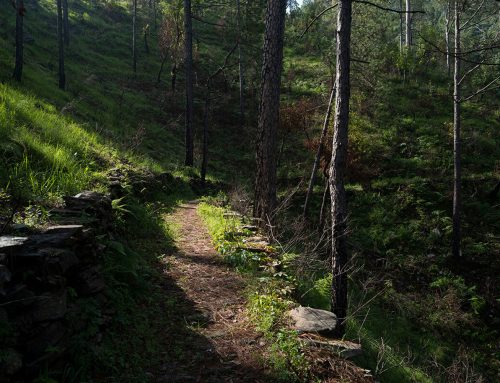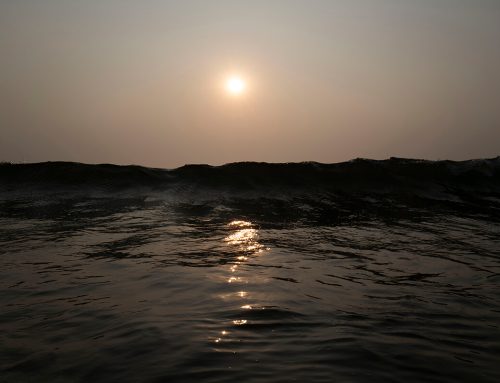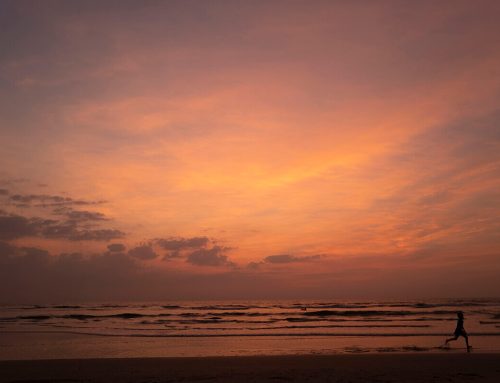I visit the ancient temple town of Maheshwar and explore the ghats, bathe in the sacred Narmada river, see the Ahilyabhai Fort and Palace, and some of the best hand-loomed textiles in India. And meet yogis.
Photographs and text by Heather Elton
Gita Mehta’s book, A River Sutra, inspired me to visit the small temple town of Maheshwar on the banks of the holy Narmada river in Madhya Pradesh. Maheshwar means the ‘abode of Lord Mahesh’, or Shiva, and is a place of irresistible charm. I’m staying at the Narmada Resort, in a sweet cottage, number 108, surrounded by gardens that overlook the river. Maheshwar has a rich history and is one of the few places where historical continuity exists from the pre-historic to modern times. The Narmada valley is a cradle of human civilisation. Archeological excavations have yielded evidence of a material culture that flourished here as early as 1500 BCE. Ancient texts refer to the town as Mahishamati or Mahissatti – the name derived from buffalos (mahisha) for which the region was famed, but it also indirectly refers Devi Durga who defeated the evil demon, Mahishasura, in the Devi Mahatmyam. All things feminine are revered here, including the sacred Narmada River, that is worshipped as Narmada maiyya (mother). And all forms of Devi are prominent in the temples. Maheshwar’s antiquity is mentioned in the ancient India texts, both Hindu and Buddhist, and inscriptions on Sanchi stupa also mention Maheshwar.
 Stone carvings of Vishnu’s avatars on the outside of the main gate to the Ahilya Fort from Maheshwar Ghat. Built in the 18th Century on the ancient city of Mahishamati, Maheshwar is mentioned in the epic stories of Ramayana, Mahabharata and the Puranas.
Stone carvings of Vishnu’s avatars on the outside of the main gate to the Ahilya Fort from Maheshwar Ghat. Built in the 18th Century on the ancient city of Mahishamati, Maheshwar is mentioned in the epic stories of Ramayana, Mahabharata and the Puranas.
Interesting legends surround the Narmada river, including that she was born from the sweat of Shiva and is celebrated as Shiv-putri, or Shankar’s daughter Shankari. Some say she is both nar (male) and mada (female); others believe she is called Narmada because she is soft, bestowing a sense of peace on the beholder. Ptolemy mentioned the Narmada in the 2 CE, and the Ramayana, Mahabharata, and the Puranas refer to her frequently. The Skanda Purana and Vayu Purana, are entirely devoted to the story of the river. The importance of the river as sacred is testified by the fact that the pilgrims perform a holy pilgrimage of a Parikrama, or circumambulation, of the river. For centuries, journeys on foot have been considered a powerful means of achieving one’s spiritual goals. A parikrama or pradakshina, a circumambulation of a sacred site or place—deities, temple clusters, hills, forests, or rivers—has been practiced by Hindus, Jains, and Buddhists since time immemorial. Her environs are a spiritual domain.
Sadhus and pilgrims walk barefoot from Bharuch in Gujarat where the Narmada merges with the Arabian Sea, along the river, to the source in Maikal Mountains (Amarkantak Hills) and back along the opposite bank of the river. It’s believed that in order to reap the benefits of this yatra, the river must always be kept on one’s right. It’s an incredible spiritual journey of about 2,600 km (1,600 mies) that usually lasts three years, 3 months, and 13 days.



 Top and second photo, stone carvings outside of the main gate to the Ahilya Fort. Third, Garuda, Vishu’s eagle vahana, sits outside the inner sanctum of the Ahilyeshwar Temple. Bottom, A guardian stands at the main gate to the Ahilya Fort.
Top and second photo, stone carvings outside of the main gate to the Ahilya Fort. Third, Garuda, Vishu’s eagle vahana, sits outside the inner sanctum of the Ahilyeshwar Temple. Bottom, A guardian stands at the main gate to the Ahilya Fort.
By 9 CE Maheshwar was already a thriving city and, probably, its population far exceeded that of its sleepy, dusty modern day version. The glory days ended with the decline of the Paramara Empire. From then on, rulers struggled for supremacy over Maheshwar. Sultan Ahmed I of Gujarat conquered the city in 1422. It changed hands once again in 1601 when it was taken over by the Mughal Emperor Akbar. The death of Aurangzeb in 1707 ended the long Mughal rule over Maheshwar when they were replaced by the Marathas under the Peshwars.
Maheshwar was made capital of the Maratha Holkar Malwa state by Maratha Queen, Rajmata Ahilya Devi Holkar, in the late 18 CE, and it served as the capital until Jan 6, 1818, when it was shifted to Indore by Malhar Rao Holkar III. Interestingly, Ahilyabai Holkar, daughter-in-law of the founder of the Holkar Maharajas of Indore, ruled from Maheshwar from, 1765 to 1795 CE. She was a woman of great diplomatic and administrative skills. She became indispensable to her father-in-law, aiding him at Indore, and running affairs of the state, while he waged war, enlarging his dominion through battle. When Ahilyabai’s husband was killed in battle, she prepared to follow him on to the funeral pyre, but her father-in-law, Maharaja Malhar Rao Holkar, entreated her not to do so, saying that he personally could not do without her, and the state needed her even more. She acquiesced. She had a dauntless spirit and courage, persuaded the Peshwa to confirm her as as an overseer of the Holkar domains, and the foundation was laid for a unique period of peace and prosperity within her realm. The rest of India, was wracked by turbulence but her good deeds span India’s breadth and width – most famously she rebuilt the Kashi Vishwanath Temple in Varanasi (and a replica here in Maheshwar).

 Sunrise on Maheshwar ghat. Birds and fish are abundant. Puja to Shiva and Shakti – the lingam and the yoni.
Sunrise on Maheshwar ghat. Birds and fish are abundant. Puja to Shiva and Shakti – the lingam and the yoni.
While supporting the resurrection of temples and dharamshalas around India, she took great care to ensure that Muslims who settled in her territories were treated equally to her Hindu subjects, consequently Ahilyabai Holkar is venerated by people throughout India. And Narmada’s Parikramavasis (pilgrims) come to her town, and her throne, to take darshan and pay their respects. Ahilya Devi Holkar embellished the city with many buildings and public works, and Maheshwar is home to her palace as well as numerous temples, a fort, and the 2 km long picturesque riverfront ghats along the timeless Narmada.
 A man hangs his freshly washed blanket to dry on the ghats.
A man hangs his freshly washed blanket to dry on the ghats.
My own pilgrimage is way shorter than the Narmada Parikrama. I’m only here for a week to check it out. I wander along the ghats early morning to see the sunrise. Already pilgrims and local inhabitants are bathing in the river, a daily ritual of washing away any impurities – physically, emotionally and mentally. The body is a temple. Maheshwar reminds me of a small Varanasi. Boatmen are preparing their crafts in hopes of people going on a boat ride, cruising along the ghats. Tourism is mostly non existent due to Covid. I don’t see a foreigner the entire time I’m here. I’m relieved there are very few people here. I was told it would be overrun during Shivaratri but that is not the case.

 Sunrise on the Maheshwar ghat. Pujaris and local inhabitants bathe themselves in the Narmada, a daily ritual of washing away any impurities physically, emotionally and mentally.
Sunrise on the Maheshwar ghat. Pujaris and local inhabitants bathe themselves in the Narmada, a daily ritual of washing away any impurities physically, emotionally and mentally.
Small shops are opening as I approach the main Maheshwar Ghat. Chai walas make tea. I buy some milk and offer it to the very sad looking skin dogs infected with mange. There are thousands of small shrines built into the stone steps an embankments of the ghats. Hindu priests do morning pujas, reciting prayers over thousands of miniature Shiva lingas (representations of Lord Shiva) made out of mud from the Narmada River.
A group of youth do calisthenics and yoga on the ghat, before heading to their makeshift gym in the grounds of an old temple complex. Good to see a couple of women lifting weights and looking strong. Later, I see them kayaking on the Narmada, probably to the rapids and waterfalls, Sahastradhara, where 108 torrents cascade from the head of Shiva. The impressive 18 CE Ahilya Fort temple complex comes into view and I wander up the large stone steps to the stunning entrance gate with exquisite stone carvings of Vishnu’s sixteen avatars. The craftsmanship is impeccable and I plan to visit the interior with it’s two temples, ornately carved with numerous bas reliefs and stone carvings, later in the afternoon.
 A Shiva lingham and Nandi shrine adorn Ahilya Ghat in front of the grand 18th CE Ahilya Palace and temple.
A Shiva lingham and Nandi shrine adorn Ahilya Ghat in front of the grand 18th CE Ahilya Palace and temple.
Behind one temple is an arts school and a group of girls invite me to watch a Kathak dance rehearsal for their performance on Shivratri. At the far end of the promenade is Peshwa Ghat, a delightful bathing spot, and choose this location for my own forays into the Narmada. It’s quiet and I won’t attract attention. Beyond that is the cremation ground.


 Sunrise on the Peshwar ghat. A delightful morning of meditation and bathing in the Narmada with these delightful humans. Discreet steel cubicles with a pretty fabric door are changing rooms for women.
Sunrise on the Peshwar ghat. A delightful morning of meditation and bathing in the Narmada with these delightful humans. Discreet steel cubicles with a pretty fabric door are changing rooms for women.
I sit in mediation on a stone outcropping at the water’s edge. Women bathe and wash clothes while children perform elaborate dives into the river with total abandon and delight, exhausting themselves and laughing. I think what a great life they must have with all this as a playground. I can’t resist going for a swim. The water is magnetising and has the soft touch of velvet. It brings about serenity and a deep calmness. I submerge myself, open to the embrace of the Mother. I feel something touch my legs. The river is teeming with fish. It is vibrantly alive. Prana.

 Conversations with yogis at Baba Ji’s hut. A Ramanandi yogi adorned with Vishnuvite tilaks.
Conversations with yogis at Baba Ji’s hut. A Ramanandi yogi adorned with Vishnuvite tilaks.
On the way back, I notice a baba sitting outside his kootie, really a cave built into the side of the fort, adjacent to the Kashi Vishvanath Temple. He invites me for chai, an invitation I graciously accept almost every day. Pujaris and locals visit him for darshan or a chat. I practice my limited Hindi, and with their broken English, I find out he’s a Ramananda yogi and has lived here most of his life. One of his chelas has painted himself in tilaks in the Vaishnavite tradition to honour Ram. Another is a very handsome young fellow who does seva by helping out this baba and his friend who is the main pujari at the Vishvanath Temple. He tells me that his tapasya is doing pranayama with long kumbhakas, submerged in the waters of the Narmada. Narmadev is the great Devi and being embraced in her energy is divine.
I head back to my hotel for a breakfast of iddlys, sambar and coconut chutney. And more chai. I take rest and then do a yoga practice.


 Top, Interesting statues most likely of royalty that illustrate the love of textiles that Maheshwar is famous for. Middle, A selection of hand-woven block printed, cotton dupattas with designs inspired from the Narmada river and the stone carvings on the temples. Bottom, Stone carvings decorate the outside of temples.
Top, Interesting statues most likely of royalty that illustrate the love of textiles that Maheshwar is famous for. Middle, A selection of hand-woven block printed, cotton dupattas with designs inspired from the Narmada river and the stone carvings on the temples. Bottom, Stone carvings decorate the outside of temples.
Maheshwar is known as a centre of handloom weaving and has produced some of India’s finest textiles since the 5 CE. Late afternoon, I take a rickshaw into town in search of the iconic Maheshwari sari. My first stop is Tana Bana Handlooms where I meet a family who have been in the business for generations. They patiently explain what makes the Maheshwar sari so famous and the history of the industry here. They tell me that Maheshwar handlooms owe their name to Maharani Ahilyabai Holkar, who in the late 1700s, invited weaver communities to come teach her people the craft of weaving in order to give them a better livelihood. The community of weavers that settled in Maheshwar originally came from Mandu, where they were weaving for the Mughals, what was then know to be the finest fabric of Madhya Pradesh. She gifted the beautiful, light textiles to the Peshwa Kings. Thus, the Maheshwari sari was conceived, originally made in Egyptian cotton, having the finest of counts (ranging from 80s to 300s), which gave the sari its signature simmering gossamer elegance.
The original sari was nine yards in length, hence named the Navari. In time, a new style emerged from cotton and 2-ply mulberry silk to produce a sari that is soft, light, and has a subtle shine – known as a chequered Garbh Reshmi sari which went on to surpass its pure cotton predecessor. Maheswari saris were traditionally made in colours like peacock blue, bright yellow, forest green, and India red made of a dye called Aal, designed with stripes of red, white and gold borders. In the ’50s-’60s, the warp changed again to single ply mulberry silk, a cheaper alternative to resham, since he Royal family could no longer ensure the quality of the cotton. This resulted in the modern incarnation of the Maheshwari sari – the Neem Reshmi. Ahilyabai, preferred geometric patterns to floral motifs, so the weavers drew inspiration from the ornate stone carvings on the fort and temple structures and the Narmada to create their unique designs. The one trait that has stood the test of time is the intricate zari, or brocade border which gives the Maheshwari sari its unique design. They are woven so that the border is reversible and you can wear the saree both ways.
The shopkeepers show me different combinations of silk and cotton, and 1- and 2-ply weave. I learn that Indian mulberry silk is becoming more rare, and consequently expensive, and that many people now order silk from China. I mention that sadly silkworms are killed in the process and they show me a very expensive champagne coloured sari with gold embroidery made from ahimsa silk.

 Top, Detail from a temple with sensuous stone carvings of yoginis, courtesans dancers and women Bottom, Silk and cotton Maheshwar saris.
Top, Detail from a temple with sensuous stone carvings of yoginis, courtesans dancers and women Bottom, Silk and cotton Maheshwar saris.
In the ‘70s, Maheshwar was far from the prosperous golden era of the 18th C. After India’s independence, the industry fell into decline when industrialisation replaced handlooms with mills, and weaver communities were left without a market for their beautify hand-woven fabric. Falling demand and low wages led to a mass migration from Maheshwar. It was only in 1978, when Richard and Sally Holkar, the young successors of the Holkar Dynasty, established The Rewha Society, a not-for-profit, to revitalise the craft and focus on women’s employment at the looms, that the weavers stayed. Rehwa is a lovely shop, located on the grounds of the Ahilyabai Palace, with an astounding collection of saris, kurtas, dupattas and stoles. I’m so overwhelmed that I need a few days to decide on the perfect gift for a few friends. I’m in desperate need of a fresh lime soda and stop at The Labbooz Cafe across the square.
The Ahilya Fort and Palace was once the home of Maharani Ahilyabai Holkar. The rambling complex now houses a museum and the Ahilya Fort Heritage Hotel, a five-star hotel that offers a panoramic view over the river and ghats, costs over $1000 a night, and has seen the likes of Mick Jagger and Ralph Fiennes. A grand staircase descends to a spacious stone courtyard by the Narmada River with the cenotaph of Vithoji Rao Holkar (the younger brother of king Yashwant Rao Holkar I, who was executed by rivals in 1801) and magnificent Ahilyeshwar Temple made as a memorial for queen Ahilya Bai. The Chhatri of Vitoji Rao Holkar has a domed roof and elaborate carvings around the base of the temple. A marble Nandi lies at the entrance of the Ahilyeshwar Temple, facing the garba griha, or womb chamber, which houses Shiva. The roof of this inner sanctum is crowned by a tower-like shikara. The pillars are carved with the avatars of Vishnu. The understanding of scale and proportion from large complexes to minor details of carvings, and other details of space making, is inspirational. I do a kora around the temples, have darshan with the deities, and photograph the elaborate sculptures and stone bas reliefs.

 The domed roof and elaborate carvings of the Chhatri of Vitoji Rao Holkar.
The domed roof and elaborate carvings of the Chhatri of Vitoji Rao Holkar.
What is quite unique in the Ahilyabai Fort are the carvings of people, which are equal in number to the deities. I’m captivated by the details of textiles and textures, and the incredible sense of style. Another temple complex has impressive sculptures of women – yoginis, courtesans and dancers – and an unusual one of a mother breast feeding her baby that I’ve never seen before on a temple in India. It takes a Queen to allow that to happen.
A golden sunset illuminates the ghats and draws everyone to the river. Devotees perform evening pujas, children feed the fish, and adolescent boys pose for photos, dive off the plinths and swim in the river. Narmada Parikrama pilgrims gather outside the Narmada mandir before finding a room in an ashram, dharamshala, or shelter for the night. I give them a donation for food. It’s a vibrant social scene and the ghats are a much enjoyed and integral part of Maheshwar life.
 Bhajans at the Nath Mandir and yogis Babaji with his chela painted in a sacred Vaishnavite tilak.
Bhajans at the Nath Mandir and yogis Babaji with his chela painted in a sacred Vaishnavite tilak.
As much as I’d like to stay for Aarti on the ghats, I’m not keen on wandering alone at night and there are very few rickshaws. Close to my hotel, is the Nath Mandir so I join them for bhajans. Yogi Gorakhnath graces the entrance of this bright yellow temple that feels like a happy place. All the devotees belonging to the ashram are elderly. A women asks me if I’d like food. I’m given some small cymbals to play and chant Hari Ram, Hari Ram, Ram Ram, Hari Hari. An hour of mantra chanting leaves me feeling absorbed and concentrated. In the morning, I’m awoken from my dream state by the same chant. A magical moment of floating on a mantra.
 I take a paddle boat out to Baneshwar Mandir, a 10 CE Shiva temple in the middle of the Narmada that is thought to be the centre of the universe as it’s on a direct axis connecting the earth to the polar star.
I take a paddle boat out to Baneshwar Mandir, a 10 CE Shiva temple in the middle of the Narmada that is thought to be the centre of the universe as it’s on a direct axis connecting the earth to the polar star.
On Shivaratri (Shiva’s birthday), I take a paddle boat to visit Baneshwar Mandir on a tiny island in the centre of the Narmada. It’s early morning and the pink hues of dawn illuminate the 10 CE Shiva temple. Inside, is a shivaling believed to have been here since the Dwapara Yuga. The triangular walls protect the temple from the strong currents of the river, which is prone to flooding. The boatman tells me Baneshwar is the centre of the universe and is on a direct axis connecting the earth to the polar star. It’s a well loved temple with water flowing through it, over the shiva lingham and out the mouth of fish carvings on the sides of the temple back into the Narmada. I’m the only one here and the priest gives me darshan. Blessed. Om Namah Shivaya!
The boat carries me back to Narmada Ghat and I head to the Kashi Vishwanath Temple for a final darshan with Shiva. This temple is a replica of Vishwanath Temple in Varanasi, which is closed to non-Hindus, so I’m grateful to have a chance to see what is considered the ‘inside the mandala’ in Maheshwar. The pujari does an amazing job of garlanding the lingham with white flowers. Pure bhakti in this Shiva loving temple town. ♦
Feature photo: The sacred Narmada River has drawn thousands of pilgrims for millennia, on a yatra, a parikrama or pradakshina, where they walk barefoot along her banks, from the source in Maikal Mountains (Amarkantak Hills) to Bjaruch in Gujarat where she merges with the Arabian Sea. It’s an incredible spiritual journey of about 2,600 km (1,600 mies) that usually lasts three years, 3 months, and 13 days.
Missing the beginning?
Start with My Pandemic Life in India: Part One – Morjim, Goa
In January 2020, I pulled the rug out from under my comfort zone and left London to live in India. A month later the Covid pandemic ravaged the planet. I decided to stay in India. Photography, travelogue and memoir is used to share my experience as a travelling yogini and how spiritual practice helped me to stay grounded in challenging times. As always, deep gratitude to my guru, Dzongsar Jamyang Khentsye Rinpoche, for his presence and teachings. 🙏🏽 Any misrepresentations of facts or dharma are totally of my own doing for which I’m sorry.





